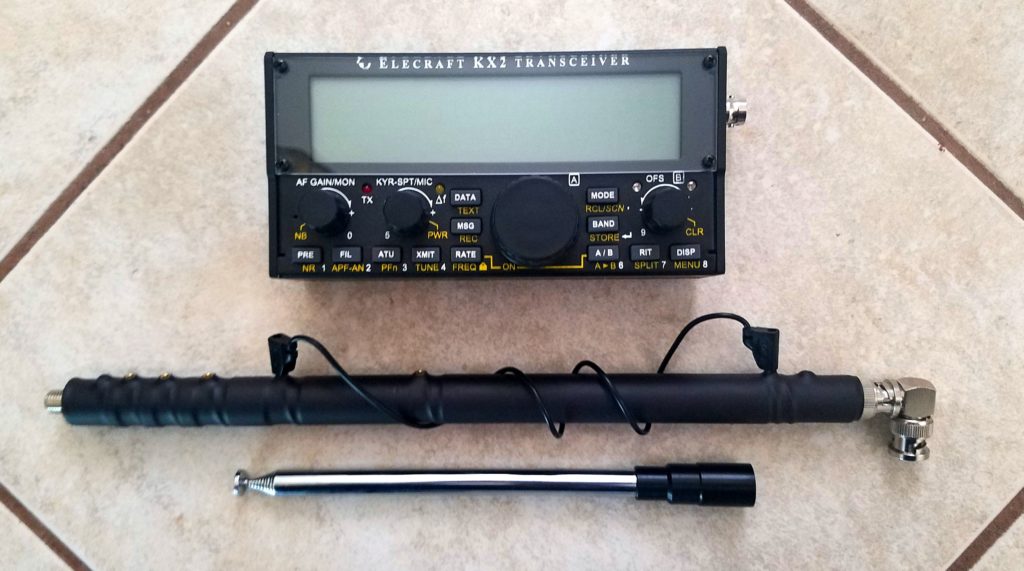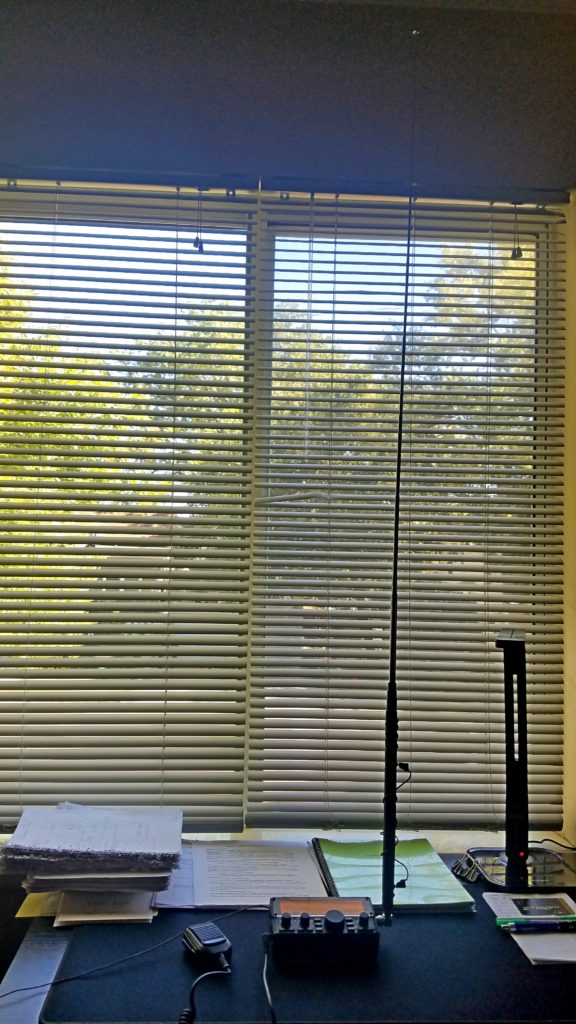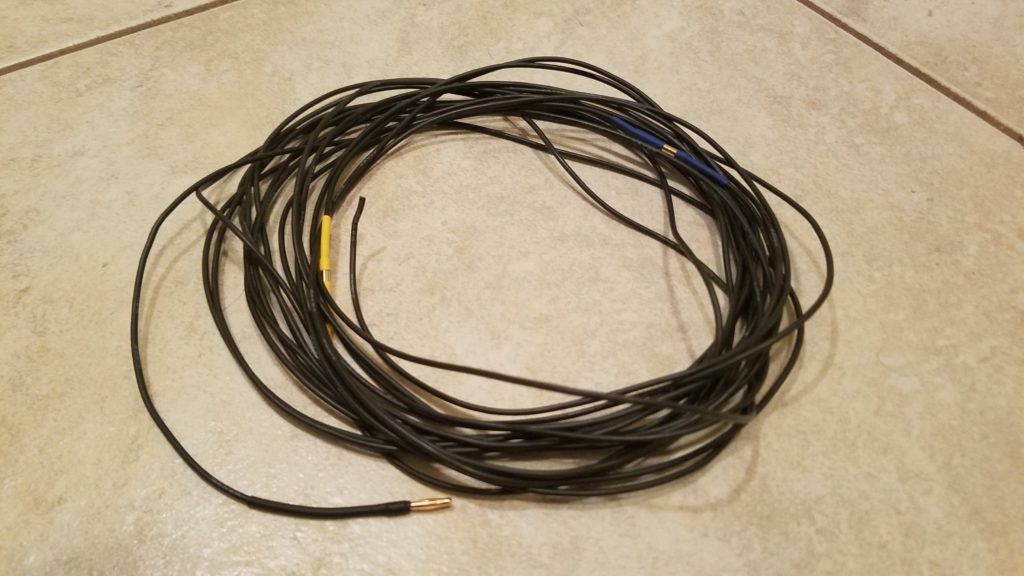Since I became an owner of an Elecraft KX2 portable HF transceiver and started building an ultra-portable field station with it, I spent quite a lot of time researching different options for compact antennas. The first one that I came up with was a random wire supported by a compact fiberglass telescoping mast. But there are situations when deployment of even such antenna can be difficult.
Adding some radio activity to your travels does not always mean the ability to set up a mast to support your wire antenna – sometimes it may be impractical due to space limitations or lack of adequate support (if you’re not carrying the tripod which adds to the weight). And in some situations, it may simply attract unnecessary attention (for example, if you are trying to work in a city park or near a historic monument). Last but not least, a compact antenna lets you experience a different kind of fun – pedestrian mobile HF radio!
We all understand very well the fundamental principle – a resonant antenna is the most efficient antenna, and all compromises (like using traps, coils, etc) let us win some space – but come at a price of lost efficiency. And sometimes this loss may be quite dramatic! Nevertheless, after seeing and reading several reviews about the Elecraft’s AX-1 antenna, I was intrigued about the capabilities of this tiny loaded whip. All in all, despite all skepticism caused by its size, there are quite a few reasonably favorable reports about its performance (mainly on CW, but I was curious about SSB too!).

However, after a careful consideration of the analogs on the market, I decided not to pursue the AX-1. I found several videos using MFJ-1899T multiband whip for “backyard portable” and pedestrian mobile – and thought to myself: “why not?” Most of those tests used Yaesu FT-817, but my KX2 has the same BNC antenna connector – I only needed to add a 90° adapter.
The 1899T from MFJ is of course not as compact as Elecraft’s AX-1 – however, the whip can be unscrewed from the coil, and the antenna becomes reasonably compact to carry in any average backpack. It is also a little heavier than the AX-1. To offset these shortcomings, it will give you all bands from 6 all the way to 80 meters using different taps on the coil (okay, I assume 80 meters will be a big stretch for it!). Per the manual, it will also perform reasonably well on the 2 meter VHF band. In comparison, AX-1 is only resonant on 20 meters, and will also give you 15 and 17 meters using your rig’s ATU (if you have one). Both antennas cost the same – $99.95 as of time of writing – and you can purchase the 40 meter add-on for AX-1 for additional $49.99.

For me, the choice was obvious – trading off a little length and weight (both not critical at all), I am getting an all-band antenna for the same price! However, theory tells us that the vertical antenna itself is only a half of what’s needed for optimal performance. Thus, I still needed to take care of a counterpoise. For convenience of the owners, MFJ-1899T’s reference sheet has a formula to calculate the optimal length of the counterpoise in feet – that’s 180 divided by the frequency in MHz.
As the whole goal is to be as compact and minimalist as possible, I decided to further keep the spirit of a “universal” tool – and make a multiband counterpoise for my multiband antenna! The design is much simpler than it may sound: using several pieces of wire and banana plug connectors, I am able to assemble a counterpoise of increasing length for all bands, 6 to 40 meters (I decided to deal with 80 meters later, if I will be so inclined – I seldom use it anyway).

For the counterpoise, I used a 22 awg tinned copper stranded silicone wire purchased on Amazon. I found silicone to be very flexible and convenient, not very prone to easily get tangled. Using my very simple soldering station (that I also bought on Amazon some time ago), I first attached the male banana plug connector that goes into the AUX/GND port of the KX2.

I next cut the wire to the length of the first counterpoise – for the 10 meter band (6.25 ft). I decided that it will be fine to also occasionally use it for 6 and 12 meters (when I will have a need to). Best thing about this design is that I can always make another cut and install an additional pair of connectors to make a precise counterpoise for a “missing” band.

At the opposite side of the cut, I installed a female banana plug connector (I should probably mention that I used the 2 mm banana plug connectors, the same size as the AUX/GND port in the KX2 and the coil taps on the MFJ-1899T). To simplify the counterpoise assembly in the future, I decided to color-code the connections between the wire fragments. Thus, I put a yellow heat-shrink wrap at the end of the 10-meter counterpoise, and the same color shrink-wrap will go to the male banana plug connector of the 20-meter counterpoise. I reconnected the wire, and cut it to the next length – 12.63 ft (or 12 ft 7 9/16 in) for the 20-meter band. I figured that it can also be used for 15 and 17 meters, if needed. I chose to mark the second connection with the blue heat-shrink wrap. The full length of the wire, as mentioned above, works for 40 meters (and occasionally for 30 meters if needed).


For the first test, I decided to get on 20 meters during the past weekend. It is the band that I normally use the most, and Pennsylvania and Arizona QSO parties were pretty active at that time. I will be honest with you – despite my prior quite positive experience with compromised indoor antennas, I was quite skeptical about this one. Just imagine how pleasantly surprised I was when the AA3B station came back to me from the first attempt! A few minutes after, I had to only call twice to hear back from K3PP. Both stations were almost 1800 miles away from me, and I got them with my KX2 at 10 W sitting inside my apartment!
One thing should be noted about tuning of this antenna. There is a mistake in the reference sheet that comes with it: for 20 meters, the jumper has to be connected to taps 1 and 3, not 1 and 2. I reported this to MFJ, and they promised to pass this info to whoever is responsible for user manuals and documentation.


I do understand that these stations were from the “big guns” (or in case of AA3B – very big guns!) that will hear you even if you will be pushing 1 watt into the dummy load. However, I was fairly pleased with the performance of this antenna, particularly with the band conditions during the weekend. I made a side-by-side comparison of reception on the KX2 with MFJ1899T and on my base Icom 7300 with Hustler 6BTV mounted outside. The signal strength was very comparable on both S-meters. However, it should be noted that the 1899T is much more noisy – thus making it harder to copy weak signals.
The 40 meter band was very noisy during the day, and I did not have time for more testing at night. Thus, further tests will follow – and I am very curious to take this little antenna with me to use in places where I can’t deploy my more efficient wire antenna. Of course I don’t expect it to perform equally well – but if it is about operating with it or not operating at all, I will take it!